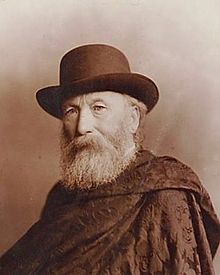29 March 1901: The death of James Stephens, founder of the Irish Republican Brotherhood, on this day. He was born in 1825 at Blackmill Street, Kilkenny, the son of John Stephens, an auctioneer’s clerk. He supported the Young Ireland movement and the Irish Confederation, and he served as aide-de-camp to William Smith O’Brien in the 1848 Rising at Ballingarry, Co. Tipperary in which he was wounded.
In the wake of this abortive affair he escaped to Paris. In the French Capital he met the Young Irelanders, John O’Mahony and Michael Doheny. He was deeply influenced by the French radicals and the underground figures that he encountered. He earned his living by teaching English.
In 1856 he returned to Ireland disguised as a beggar. His purpose was to establish a new secret revolutionary society that would achieve Irish independence from British rule by the use of military force. He travelled the Country incognito establishing networks and organising cells. On St Patrick’s Day 1858 he founded in Dublin the ‘Irish Revolutionary Brotherhood’, which became known later as the ‘Irish Republican Brotherhood’ (aka IRB). It was secret and oath-bound Society. Stephens structured it on military principles with himself as the ‘Head Centre’.
In 1858 Stephens went to America to raise funds for the IRB. When he returned to Ireland in 1859 the British knew well who he was and what he was doing, and so he returned to America. He seized nominal headship of the sister movement in the USA, ‘the Fenians’ in early 1859. From 1861 to 1866 Stephens’s influence was at its height. The IRB flourished in Ireland, Britain and the USA.
He had returned to Ireland in 1861 and renewed his activities, building up a numerous but very lightly armed Revolutionary structure. Gaining the support of Irish soldiers in the British army and importing arms shipments were meant to overcome the lack of weaponry. However in 1865 Stephens suddenly suspended a planned Rising after calling all the leaders together in Dublin and after interviewing them one by one he succeeded in getting them all to agree that the time was not ripe to overthrow British rule.
But by now the British were alert to what was afoot and the scale of the preparations – they decided to strike and break up the IRB. During the same year they raided IRB headquarters in Dublin, situated at the newspaper office of the Irish People where many of the IRB worked as journalists and used as a base. Most of the leaders were arrested and were convicted of ‘treason and felony’ and sentenced to penal servitude. Stephens, having avoided immediate arrest, was picked up with Charles J. Kickham for conspiracy and was imprisoned in Richmond Gaol, Dublin. However, in a brilliant but relatively straightforward rescue he was sprung from captivity by Breslin and John Devoy and spirited out of the Country to Freedom.
But his star was waning, more especially so as he attempted once again to convince supporters in the USA (where he was in exile) that a Rising was out of the question in 1866 too. Col Kelly replaced him as Head Centre. The American Fenians denounced him as a ‘rogue, impostor, and traitor’. Stephens went to France where he worked as a journalist and an English teacher. He spent the years thereafter in France, Belgium and the USA. In 1890 Charles Stewart-Parnell worked his influence to allow the British to permit his return home. A public subscription was raised by friends in Ireland to facilitate this. Thus Stephens returned home to Ireland in 1891. He spent the remainder of his life in seclusion in Blackrock, Co. Dublin, avoiding anymore political intrigue.

No comments:
Post a Comment